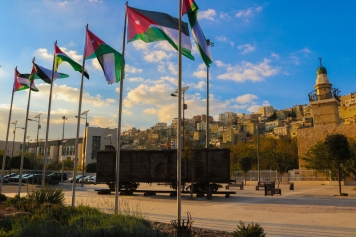
Naour is a destination sought by the residents of Amman and the surrounding areas for leisure and enjoyment of the natural landscapes and beautiful atmosphere, away from the city's hustle and the overwhelming crises. It is characterized by its agricultural lands and fertile soil, which have led the local residents to engage in agriculture, especially the cultivation of fruit-bearing trees such as olive, grapevine, fig, and various types of vegetables and fruits.
Naour is considered the gateway to the Dead Sea and the Jordan Valley. It is bordered by the Dead Sea and the southern Jordan Valley to the west, while Amman borders it to the west through areas like Kharibet Al Souq and the International Airport Street. To the north, it is bordered by Wadi Al Bahath and Iraq Al Amir, and its southern borders extend to Madaba Governorate.
Naour has a rich history dating back to ancient times. Ancient artifacts have been discovered in the area, dating back to the periods of the Hyksos, Ammonites, and Moabites. Some artifacts are also believed to date back to the Roman, Greek, and various Islamic eras. In the year 1900, Circassian immigrants settled in Naour after being forcibly displaced from their homeland (Caucasus) due to colonial wars in their home country by the Ottoman Islamic Caliphate authorities, to prevent them from falling under Russian slavery. Since that time, the Circassians played a significant role in establishing the town. Naour hosted prominent Circassian tribes such as Abzakh, Bzadugh, and Kabardi. The Circassians contributed greatly to the town's development by revitalizing agricultural activities, cultivating orchards, vineyards, crops, and legumes. Their role expanded to include trade activities, as they established the town market that included food stores, mills, and blacksmiths. They also played a role in boosting education in Naour, founding the town's school in the eastern part of Naour for Quranic education and literacy.
The town of Naour was founded in 1960. The development of Naour began in 1973 when it became a directorate, and it became a district in 1985. In 1996, it was upgraded to a governorate, and the Naour District was later divided into the Hassban District and the Umm Al Bassateen District. The district also includes the following cities and villages:
- Al Adasiyah
- Al Manshiyah
- Umm Al Qutain
- Qarat Turk
- Adeeban
- Al Mansoura
- Al Bunayat
- Umm Al Summaq
- Bissat Naour
Over time, Naour flourished and grew to become a city populated with various residents and commercial markets. It maintained its agricultural nature while still serving as an important destination for trips and leisure activities. It now hosts numerous Jordanian tribes, including Al Ajarami, Al Ramamneh, Al Adwan, Al Thuwabiah, in addition to the Circassians who migrated to Naour long ago.
Most of Naour's residents are original landowners and members of tribes who prefer living in independent houses or villas. As a result, the real estate in Naour is characterized by distinct homes and villas. Over time, Naour has become a preferred choice for building private farms due to its flat terrain and suitable soil for agriculture. The real estate investment in Naour is continuously evolving, and its proximity to Amman has attracted real estate investors and those seeking a quiet residential area with a rural nature. Most real estate properties in Naour are offered for sale, especially lands, villas, and farms. You can find the most important real estate in Naour through the Homes Jordan website, including:
- Apartments for sale in Naour
- Residential lands for sale in Naour
- Commercial lands for sale in Naour
Real estate prices in Naour are generally moderate and accessible to many, making it suitable for real estate development, which opens the door for various real estate investments and development that aligns with its location, size, and provision of services.
- Kharibet Khalifa
- Al Jalahaa
- Al Masdar
- Umm Areejat
- Ayyun Al Jamous
- Wadi Al Kabra
- Bal'as
- Umm Ramanah
- Ayn Al Marj
- Al Suleit
- Al Hajjar
- Al Boyda
- Khushroom
- Al Awailiyah
- Rajm Al Saour
- Umm Tina
- Al Sannourat
- Abu Al Asaker
- Al Manif
- Al Qahqeer
- Areqoub Umm Al Qutain
- Marj Ska
- Al Omriyah
- Marj Al Hukr
- Al Mu'ayliq
- Al Baseh
- Breeh
- Bayt Zaraa
- Qadaqda
- Al Balad
- Al Tawal
- Al Marasseh
- Al Madurah
- Abu Sayfein
- Umm Al Summaq
- Al Hawayti
- Naour Waterfalls
- Hussban Stream
- Amman Climbing Gym
- Naour Viewpoint
- Suro Forest Park
- Green Land Park
- Abd's Palace (Historical Monument)
- Tal Hussban
- Dead Sea Road
- Al Salam Street
- Madaba Western Street
- Al Sharif Al Hussein bin Ali Street
- King Abdullah II Street
- King Talal bin Abdullah Street
- King Hussein bin Talal Street
For further inquiries about specific lands and real estate in Naour, feel free to get in touch with the Homes Jordan team. They take pride in having a group of top real estate and engineering consultants who can assist you in making the right decision for your real estate requirements, saving you the hassle of searching and handling all the procedures related to buying and selling.